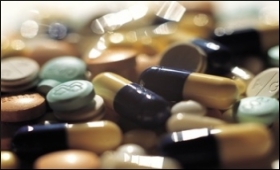|
|
|

|
Pharma sector to grow 4-6 pc in FY-2021
|
|

|
|
| Top Stories |
 |
|
|
|
SME Times News Bureau | 08 Aug, 2020
The domestic pharma industry is expected to grow at a 4-6 per cent in
FY-2021 owing to Covid impact, though FY 2020-2023, CAGR is expected to
be in the range of 8-11 per cent on the back of healthy demand from the
domestic market given increasing spend on healthcare along with
improving access, rating agency ICRA has said.
In its analysis of
the pharma industry in India, the rating agency said that along with
demand growth in India, moderation in pricing pressure for US market,
new launches and market share gains for existing products and
consolidation benefits will drive growth for the industry over the
medium term.
Several Indian pharma companies (Aurobindo, Dr.
Reddy, Glenmark) have acquired US ANDA (abbreviated new drug
application) portfolios which will aid growth going forward. The growth
in FY-2021 is expected to be supported by 1.88 per cent WPI linked price
hike for domestic NLEM (National List of Essential Medicines)
portfolio.
The prospect for current year comes on the backdrop of
the Indian pharmaceutical industry's stable growth of eight per cent
during FY-2020 led by rebound in domestic growth in Q2 FY-2020 to 14.2
per cent (Q1 FY-20 at 4.8 per cent) supported by seasonal factors and
stable growth in chronic therapies.
Based on the trends, ICRA
Vice President and Co-Head Gaurav Jain said, "The global demand scenario
is largely expected to remain stable for Indian pharmaceutical industry
owing to inelastic nature of prescription drugs though some impact on
volume growth will be felt owing to lockdown (lesser OPDs/elective
surgeries) and lower economic growth. The impact of lower demand will be
felt more in less developed countries which are additionally negatively
impacted owing to low crude oil prices."
As per ICRA research,
post onset of Covid-19, manufacturing activity has gradually started in
China with shipments/air cargo arriving in India for APIs, Intermediates
and KSMs (Key Starting Materials). This has led to production
continuation for Indian players though the capacity utilization across
plants is yet to reach pre-Covid-19 levels.
The lower capacity
utilization is largely contributed by restricted movement of personnel
and availability of non-critical raw material (e.g. packaging material)
during the lockdown period in India. Indian players hold 2-4 months of
inventory (raw material & finished goods) and similar levels in
distribution channel (finished goods) which will largely suffice demand
in the near term till situation normalizes.
The outbreak of the
Coronavirus in China and the consequent lockout in parts of China had
earlier resulted in a shutdown of production units in China. The
domestic pharmaceutical industry is highly dependent on imports, with
more than 60 per cent of its active pharmaceutical ingredients (API)
requirement being imported, and in some, specific APIs like
cephalosporins, azithromycin and penicillin, the dependence is as high
as 80-90 per cent. Of the total imports of APIs and intermediates into
India, China accounts for 65-70 per cent.
The recent introduction
of Rs 10,000 crore bulk drugs park and production linked incentives for
API manufacturers by the Government of India will lead to reduced
dependence for the domestic formulators on imports from China and augurs
well in the long run to manage supply disruptions, the agency said.
The incentive scheme covers 53 APIs which are critical from import dependence on China with few API/KSM being entirely imported.
As
for the growth and profitability, the same would however be constrained
by regulatory interventions such as price controls, compulsory
genericisation for domestic market. For the US market, faster generic
approvals and continued regulatory overhang with respect to
manufacturing quality deficiencies highlighted during USFDA audits
remains key concern.
The pace of ANDA approvals has more than
doubled over the FY 2014-2019 period leading to higher competitive
intensity. The pace of official action post USFDA audit has also
increased during the FY-2019 period with 16 warning letters compared to
seven in FY-2018.
The margins have remained flattish in FY-2020
at 20.3 per cent for ICRA sample of 14 leading companies led by cost
cutting measures including R&D optimisation efforts by Indian
Players. Though margins remain healthy, pricing pressures for the US
base generics business (albeit moderating); lack of limited competition
products and manufacturing quality issues will continue to put margin
pressure. Higher share of domestic business and operational efficiencies
will provide overall cushion to margins.
Unlike in the past,
when several Indian pharma companies ramped up their R&D spend,
targeting pipeline of specialty drugs, niche molecules and complex
therapies, this time around companies are optimising their R&D spend
owing to above mentioned factors. Also, with competitive pressures
expected to sustain in the near to medium term, companies are exiting
product development of easy to manufacture, simple generics with
multiple players and focusing on complex generics and specialty
products.
According to ICRA, Indian companies are unlikely to
significantly modify current spend on R&D development which will
support their long-term growth prospects. With R&D optimization
efforts underway to counter US pricing pressure, the aggregate R&D
spend is expected to be maintain at current levels of 6.5-7.5 per cent
compared to earlier 8-9 per cent for sample companies. This will be
despite requirements arising from expanding presence in complex therapy
segment such as injectables, inhalers, dermatology, controlled-release
substances and even biosimilars.
|
|
|
| |
|
|
|
|
|
|
|
|
|
|
|
|
|
|
| |
| Customs Exchange Rates |
| Currency |
Import |
Export |
US Dollar
|
₹91.25
|
₹89.55 |
UK Pound
|
₹122.85
|
₹118.85 |
Euro
|
₹107.95
|
₹104.3 |
| Japanese
Yen |
₹59 |
₹57.1 |
| As on 29 Dec, 2025 |
|
|
| Daily Poll |
 |
 |
| What is your biggest hurdle to scaling right now? |
|
|
|
|
|
| Commented Stories |
 |
|
|
|
|
|
| |
|